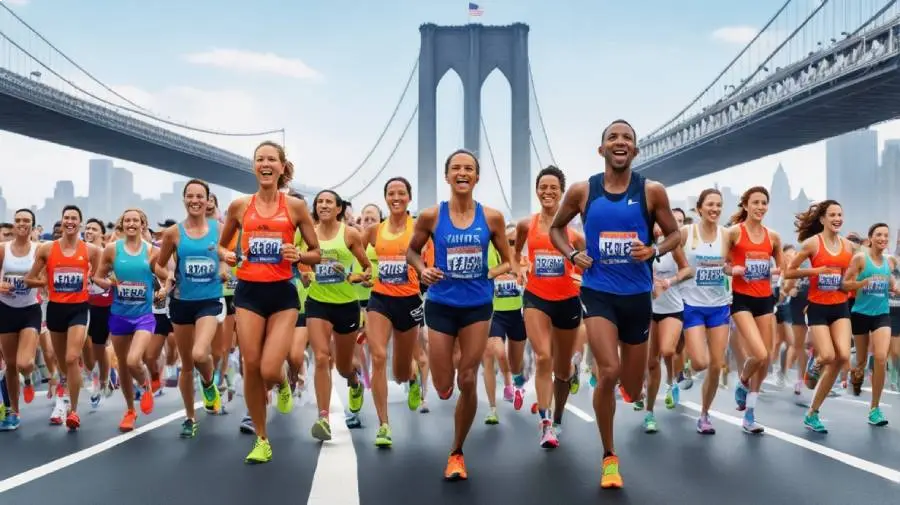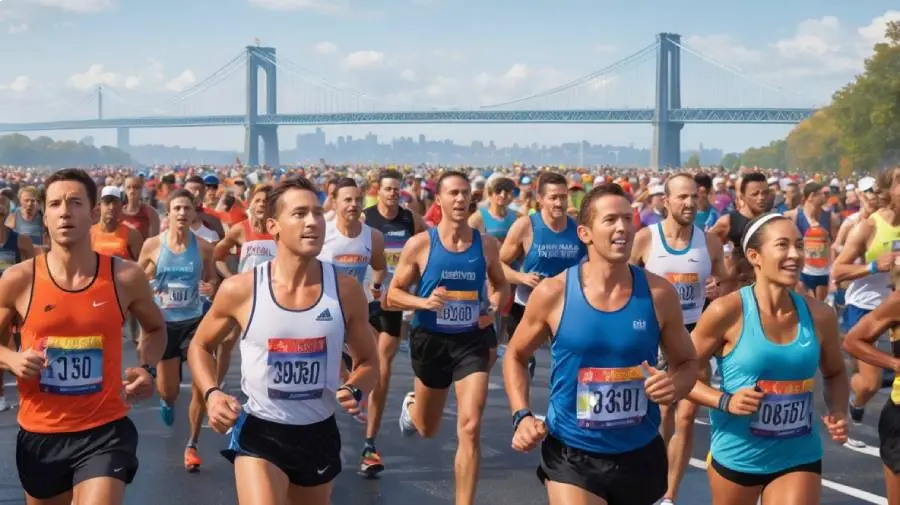New York City Marathon
Overview of the New York City Marathon: A Prestigious Race Across Five Boroughs
The New York City Marathon, one of the world’s most iconic and celebrated marathons, draws over 50,000 runners annually, making it a global athletic phenomenon. Held on the first Sunday of November, the 2025 edition will take place on November 2. Runners from all corners of the world will tackle a challenging 26.2-mile course that weaves through all five boroughs of New York City: Staten Island, Brooklyn, Queens, the Bronx, and Manhattan. But what makes this marathon so special? Let’s dive into the history, course details, key milestones, and the incredible impact this race has on the city.

Historical Background: The Birth of the Marathon
The New York City Marathon has a fascinating history, starting from humble beginnings. The marathon was first organized in 1970 by Fred Lebow and Vincent Chiappetta. Initially, the race only had 127 participants, and the route was confined to loops around Central Park. Gary Muhrcke became the inaugural winner of the marathon that year, marking the beginning of a journey that would transform the event into a global spectacle.
You may also like:- Veterans Day
- Day of the Dead
- International Men’s Day
- Black Friday
- All Saints’ Day
- No Shave November
- Native American Heritage Month
- Movember
- Daylight Saving Time Ends
- All Souls’ Day
- Iran Hostage Crisis
- Marine Corps Birthday
- World Kindness Day
- Thanksgiving Day
- Small Business Saturday
- World Toilet Day
- American Indian Heritage Day
- National Adoption Day
- America Recycles Day
Key Milestones in the Marathon’s History
- 1970: The first New York City Marathon took place, with Gary Muhrcke as the first-ever winner.
- 1976: The marathon expanded to include all five boroughs to celebrate the U.S. bicentennial, solidifying its current format.
- 2012: The marathon was canceled due to the devastating effects of Hurricane Sandy, marking a rare moment of disruption in the event’s history.
The marathon’s growth over the years, both in terms of participation and global recognition, has turned it into one of the largest and most prestigious marathons worldwide.
The Marathon Course: A Journey Through New York City
The New York City Marathon features a scenic and challenging 26.2-mile course that takes runners through all five boroughs of the city. Let’s break down the major segments of this legendary race.
Staten Island to Brooklyn
The marathon begins at Fort Wadsworth on Staten Island, where runners face the first challenge: crossing the Verrazzano-Narrows Bridge, one of the longest suspension bridges in the world. The bridge offers a stunning panoramic view of New York Harbor and marks the official start of the race.
Brooklyn to Queens
As runners move from Staten Island into Brooklyn, they traverse the bustling streets of Brooklyn. Crossing over the Pulaski Bridge, participants enter Queens, where the atmosphere shifts to a more suburban feel.
Queens to Manhattan
One of the most iconic parts of the New York City Marathon is crossing the Queensboro Bridge. The bridge offers a moment of quiet before participants enter the heart of Manhattan, where the energy level spikes.
Manhattan to the Bronx
Runners briefly leave Manhattan as they cross into the Bronx via the Madison Avenue Bridge. While this is one of the shortest parts of the course, it is a symbolic crossing between two of New York’s most vibrant boroughs.
Return to Manhattan and Finish in Central Park
The final stretch of the marathon sees runners return to Manhattan, culminating in a thrilling finish in Central Park, near Tavern on the Green. This iconic finish line is where thousands of spectators cheer on exhausted but triumphant runners.

Key Route Information: Start Times and Details
Understanding the start times and logistical details of the marathon can help spectators and participants plan their day. The race kicks off in waves, with the following start times:
- Wheelchair division: 8:00 AM
- Women’s division: 8:35 AM
- Men’s division: 9:05 AM
- Final wave: 11:30 AM
Participants have until 10:00 PM to finish the race, making it a long but rewarding day for everyone involved.
Total Distance: 26.2 miles
Time Limit: 14 hours
Spectator Information: Best Spots to Watch the Marathon
The New York City Marathon is not just an event for runners; it’s a massive spectator occasion, with approximately two million people expected to line the streets to cheer on the participants. Here are some of the best viewing spots:
- Fourth Avenue in Brooklyn (Miles 2-4): A prime spot for watching runners in the early stages of the race.
- Fifth Avenue near Central Park (Miles 23-24): This location gives spectators a chance to witness the intense final stretch as runners push towards the finish line.
Due to security measures, spectators are advised not to access the starting area on Staten Island.
Impact and Significance of the NYC Marathon
The New York City Marathon is much more than just a sporting event. It has a profound impact on the local community and economy. The influx of runners, their families, and spectators generates substantial revenue for the city, with hotels, restaurants, and local businesses benefiting from the marathon’s popularity.
Economic Boost
With over 50,000 runners and an estimated 2 million spectators, the marathon contributes millions of dollars to New York City’s economy. Visitors flock to the city not just for the race but also to experience its culture, food, and entertainment.
Global Celebration
This marathon draws athletes from all over the globe, creating a vibrant, multicultural atmosphere. It celebrates the spirit of endurance, diversity, and human achievement, all set against the backdrop of one of the world’s most exciting cities.
Records and Achievements: Fast Times and Remarkable Moments
The New York City Marathon has been the stage for several record-breaking performances over the years. Some of the standout achievements include:
- Fastest Men’s Record: Geoffrey Mutai of Kenya set the fastest men’s record in 2011 with a time of 2:05:06.
- Fastest Women’s Record: Margaret Okayo holds the fastest women’s record, set in 2003, with a time of 2:22:31.
Additionally, the marathon has become a platform for charity, with many runners participating to raise money for important causes. Whether it’s supporting cancer research or helping children in need, the NYC Marathon offers a chance for runners to make a difference.
A Symbol of Global Unity and Perseverance
The New York City Marathon is a true celebration of human endurance and spirit. As runners take on the challenging 26.2-mile course through all five boroughs of New York City, they are not just participating in a race—they are becoming part of a global community. Each year, the marathon brings together athletes, spectators, and volunteers from around the world, united by a common goal: to complete the race and celebrate the achievement. Whether you are a runner, a spectator, or someone who simply admires the determination of these athletes, the New York City Marathon is an event that never fails to inspire.
Frequently Asked Questions (FAQs)
1. When is the New York City Marathon 2025?
The 2024 New York City Marathon will take place on November 2, 2025, on the first Sunday of November.
2. How long is the New York City Marathon course?
The race covers a distance of 26.2 miles (42.195 kilometers).
3. What is the fastest time ever recorded in the New York City Marathon?
The fastest men’s time is 2:05:06, set by Geoffrey Mutai in 2011, while the fastest women’s time is 2:22:31, set by Margaret Okayo in 2003.
4. Can I watch the New York City Marathon as a spectator?
Yes! Thousands of spectators line the streets to cheer on the runners. Popular spots include Fourth Avenue in Brooklyn and Fifth Avenue near Central Park.
5. How can I participate in the New York City Marathon?
You can enter the marathon by registering through the official lottery system, qualifying with a fast time in other races, or securing a spot through charity programs.


